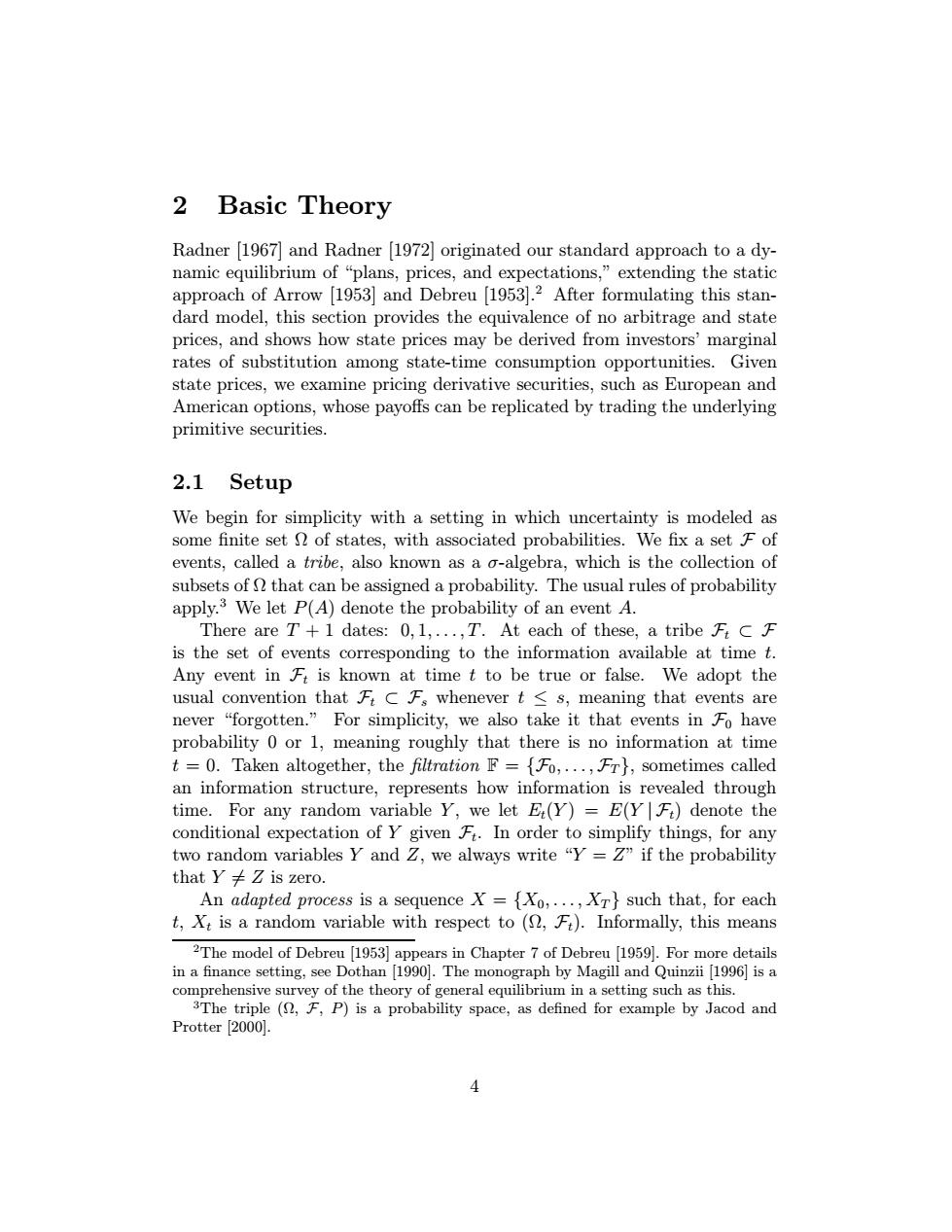正在加载图片...

2 Basic Theory Radner [1967 and Radner [1972 originated our standard approach to a dy- namic equilibrium of "plans,prices,and expectations,"extending the static approach of Arrow [1953]and Debreu ([1953].2 After formulating this stan- dard model,this section provides the equivalence of no arbitrage and state prices,and shows how state prices may be derived from investors'marginal rates of substitution among state-time consumption opportunities.Given state prices,we examine pricing derivative securities,such as European and American options,whose payoffs can be replicated by trading the underlying primitive securities. 2.1 Setup We begin for simplicity with a setting in which uncertainty is modeled as some finite set of states,with associated probabilities.We fix a set F of events,called a tribe,also known as a o-algebra,which is the collection of subsets of n that can be assigned a probability.The usual rules of probability apply.3 We let P(A)denote the probability of an event A. There are T+1 dates:0,1,...,T.At each of these,a tribeFF is the set of events corresponding to the information available at time t. Any event in F is known at time t to be true or false.We adopt the usual convention that Fc Fs whenever t s,meaning that events are never "forgotten."For simplicity,we also take it that events in Fo have probability 0 or 1,meaning roughly that there is no information at time t =0.Taken altogether,the filtration F={Fo,...,Fr,sometimes called an information structure,represents how information is revealed through time.For any random variable Y,we let E(Y)=E(YF)denote the conditional expectation of Y given Ft.In order to simplify things,for any two random variables Y and Z,we always write "Y=2"if the probability that Y≠Z is zero. An adapted process is a sequence X={Xo,...,Xr}such that,for each t,X:is a random variable with respect to (F).Informally,this means 2The model of Debreu [1953]appears in Chapter 7 of Debreu [1959].For more details in a finance setting,see Dothan [1990].The monograph by Magill and Quinzii [1996]is a comprehensive survey of the theory of general equilibrium in a setting such as this. 3The triple (F,P)is a probability space,as defined for example by Jacod and Protter [2000].2 Basic Theory Radner [1967] and Radner [1972] originated our standard approach to a dynamic equilibrium of “plans, prices, and expectations,” extending the static approach of Arrow [1953] and Debreu [1953].2 After formulating this standard model, this section provides the equivalence of no arbitrage and state prices, and shows how state prices may be derived from investors’ marginal rates of substitution among state-time consumption opportunities. Given state prices, we examine pricing derivative securities, such as European and American options, whose payoffs can be replicated by trading the underlying primitive securities. 2.1 Setup We begin for simplicity with a setting in which uncertainty is modeled as some finite set Ω of states, with associated probabilities. We fix a set F of events, called a tribe, also known as a σ-algebra, which is the collection of subsets of Ω that can be assigned a probability. The usual rules of probability apply.3 We let P(A) denote the probability of an event A. There are T + 1 dates: 0, 1,...,T. At each of these, a tribe Ft ⊂ F is the set of events corresponding to the information available at time t. Any event in Ft is known at time t to be true or false. We adopt the usual convention that Ft ⊂ Fs whenever t ≤ s, meaning that events are never “forgotten.” For simplicity, we also take it that events in F0 have probability 0 or 1, meaning roughly that there is no information at time t = 0. Taken altogether, the filtration F = {F0,..., FT }, sometimes called an information structure, represents how information is revealed through time. For any random variable Y , we let Et(Y ) = E(Y | Ft) denote the conditional expectation of Y given Ft. In order to simplify things, for any two random variables Y and Z, we always write “Y = Z” if the probability that Y 6= Z is zero. An adapted process is a sequence X = {X0,...,XT } such that, for each t, Xt is a random variable with respect to (Ω, Ft). Informally, this means 2The model of Debreu [1953] appears in Chapter 7 of Debreu [1959]. For more details in a finance setting, see Dothan [1990]. The monograph by Magill and Quinzii [1996] is a comprehensive survey of the theory of general equilibrium in a setting such as this. 3The triple (Ω, F, P) is a probability space, as defined for example by Jacod and Protter [2000]. 4